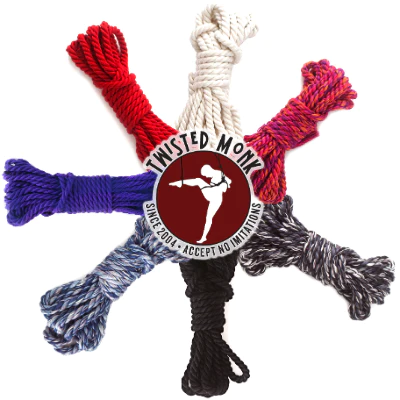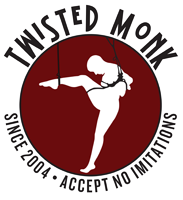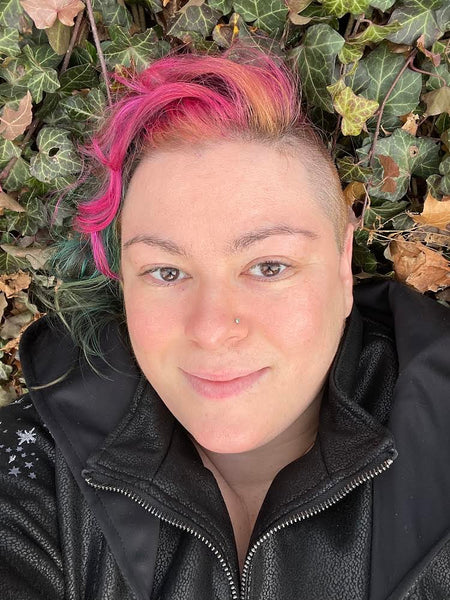20th Anniversary Interview: How It All Began part 1 of 3
As told to Rose DeYott and Ryn Pfeuffer
Many business success stories don't follow the typical narrative. The road to entrepreneurial fame is often paved with headaches, hang-ups, and setbacks—especially in the kink industry.
A large part of a business's success is the owner's capacity to adapt and persevere in the face of adversity. It requires surrounding yourself with people who inspire and challenge you.
The story of The Twisted Monk is one of fearlessly wandering down a road few have traveled. The Twisted Monk was founded in 2004 when Monk began experimenting with rope bondage and dyed a batch of rope for his own use. The response was so positive that he started making more for others, eventually earning high praise and respect in the rope bondage business.
Fast forward to The Twisted Monk's 20th anniversary. At 53, Monk jokes that it's tough to talk about the origin stories because "Like, oh God, why does anybody want to hear this freaking story again?" he laughs. "Well, it's a whole new audience, a whole new generation. And to be perfectly honest with you, to think that something that I did here in my backyard has that kind of legacy and had that kind of legs."
The story starts
At the start of the new millennium, Monk was disheartened by the tech industry. "I was disillusioned because you give hours and hours of your blood, sweat, and creativity to create a product that, if you are successful enough to have it actually go to market (because many don't), at the end of the day, you just gave your heart and soul and have nothing to show for it," he says.
Monk went on to study to be a combat actor—basically wearing a suit of armor and getting knocked off horses. He then dabbled in photography and film. "I started working on porn sets as a cameraman and an editor," he says. A black and white photography fan, he also tried to reproduce those erotic French postcards from the turn of the 19th to the 20th century in sepia tone with digital technology and hand-painted color accents. Think sultry women sprawled on a brocade couch, painted in subtle pastels. "Of course, I ran out of things to color because you can only do so many drapes, couches, and flowers," he says.
And then, somebody said, you should try rope. Monk scratched his head in thought; he knew nothing about rope. "I mean, I was a Boy Scout. I was a really good Boy Scout. I was an Eagle Scout, actually," he says, so he did know some knots. Also around the same time, his mother-in-law came out as kinky—and started a DS relationship. "This completely threw us all for a loop," he says. "So, my wife, Tam, and I being, very sex-positive, decided to educate ourselves on all things kink."
Bondage for beginners
Oddly enough, once Monk and his wife started exploring kink, his mother-in-law gave him a copy of Midori's book, The Seductive Art of Japanese Rope Bondage. When he received the book, Monk did what everybody does—he went to the hardware store and bought some cheap nylon rope.
"My GGG partner was like, well, let's try this out”. (GGG is a term coined by sex columnist Dan Savage to represent the qualities he thinks make a good sexual partner. GGG stands for "good, giving, and game." Think "good in bed," "giving of equal time and equal pleasure," and "game for anything—within reason.")
Midori's book had a recipe for hemp rope and explained why hemp fibers are preferable for this type of bondage. So, Monk, being a crafty nerd, having dyed fabrics to make costumes and hammered steel to work on armor, went down to the local hippie store to buy a tiny spool of hemp. He followed Midori's recipe and tooled around with colors in a kettle in his backyard, striving for a burgundy hue. It wasn't long until he said to Tambo, "Hey, sweetie, you wanna try this '’being tied up thing again?" She was like, "Let's give it a whirl." Monk tied her up, and she gasped, "Oh, my God, you need to learn more of this. This is awesome."
Work from home
At this point, all rope-making operations still took place in Monk's suburban garage-based workshop. He would cook rope and then hang the colored rope on the garden trellis to dry. "I should note that I have very nosey backyard neighbors," he says.
One day, one of the nosey neighbors asked what was up with all the colored rope. Quick thinking, Monk replied, "Oh, well, you've seen me walking around my front yard in a full suit of armor. I'm making Japanese armor, and with traditional Japanese armor, you don't use leather. It's actually roped and knotted, so all this rope is for the knotting and attaching all the plates of armor."
"Wow, that's gotta be a really big suit of armor for that much rope," said the neighbor.
Take a chance
Fast forward a couple of months, and as luck would have it, the Center for Sex Positive Culture (CSPC, then known as The Wet Spot) had just started offering a rope bondage class. "I go to this class with this burgundy rope, and as soon as the class is over, it's like, ''Oh my God, I've never seen this before. Will you sell this?'' Monk shrugged, "I don't know."
By then, the unemployment checks from the tech gig had run out. Monk was in full tilt, figure-out-what's-next mode. In a stroke of perfect timing, there was a vendor fair six weeks later at the CSPC. Tambo was like, "What the fuck? Try it out." So, they made as much rope as we could in their backyard. It was maybe 1000 feet.
But Monk and Tambo showed up, split a 6-foot-long card table with another vendor, and sold every piece of rope—despite not having a business name. "At first, people were like, why do I wanna buy this? It's just rope," he says. "But we sold it. We sold it all. Nobody had ever seen it before. Or if they'd seen it, they [‘d] . . . never seen it like these crazy ass colors. We were like, wow, wow, wow."
A brand is born
A few months later, there was a convention called KinkFest in Portland. Monk applied to sell at the event. At this point, there's no such thing as a bondage rope vendor. So Monk had to convince them. He called on the late legendary director of the CSPC, Allena Gabosh, to vouch for him. "No, no, this guy's cool," she attested. "It's a legit product. I know you're used to selling floggers and leather gear, but he's legit. Give him a shot."
That's when Monk came up with the name, and the branded site, The Twisted Monk, was born. He kicked production into high gear and spent the next four months making as much rope as humanly possible—at this point, it's maybe 4-5,000 feet.
"So, we go to KinkFest. I have my little Kinko's printed banner out front—which we still have—and sold every fucking piece of rope we had."
Cult of personality
At the time, social media was really in its infancy. Things we take for granted now, like Patreon, GoFundMe, or even YouTube and Twitter, had yet to be invented. So, The Twisted Monk took to the earliest forms of social media to tell the story to build the brand. "I probably spent the first 10 years telling the company's story," says Monk. He jokes that he mortgaged a lot of his private life to build the brand because he shared not only the story of starting a rope company but also his personal journey. "My journey of non-monogamy and kink really resonated with customers, and that's what created Twisted Monk as a brand," he says. "But, in the last 10 years, I've been trying to let the brand stand on its own."
Risky business
After having wild success at KinkFest, people wanted more. Remember, this was pre-online payment tools like PayPal, Stripe, and Square. People weren't paying with credit cards yet, so business transactions were all cash and checks.
"We're like, well, shit, maybe this is a thing," says Monk. So, he took his tiny nest egg, his retirement, his 401K, from when he worked in dot-coms. "It was a tiny amount of money, and I cashed it all in," he says. "I went, OK, here's my retirement, here's everything, every dime I have in the world. We're going to do this." And he started selling online.
Keep an eye out for part 2!
Rose (she/they) is one of Twisted Monk’s own, Monk’s nibling in fact. They bring their experience as a gender and sexuality history writer to editing Twisted Monk’s blog, and her eye for color is responsible for our Limited Edition hemp dye jobs. You can often find Rose wandering the local woods looking for foragables, rope shoot locales, and color inspiration.
Insta: @rosytheropemaker
Fetlife: @rosytheropemaker
Ryn Pfeuffer is a queer sex and relationships writer. Over the past two decades, her work has appeared in more than 100 media outlets including Marie Claire, Men's Health, Playboy, The Globe and Mail, The Washington Post, and WIRED. She lives in Seattle . You can find her on Twitter @rynpfeuffer or IG @ryn_says.
Also in News

Exotic Bamboo Rope Review by Pete Riggs of Ropeconnections.com
Pete Riggs of Ropeconnections.com recently did a very through and in depth review of our exotic bamboo ropes, including washing! Check it out, along with tons of other great rope content and tutorials!


